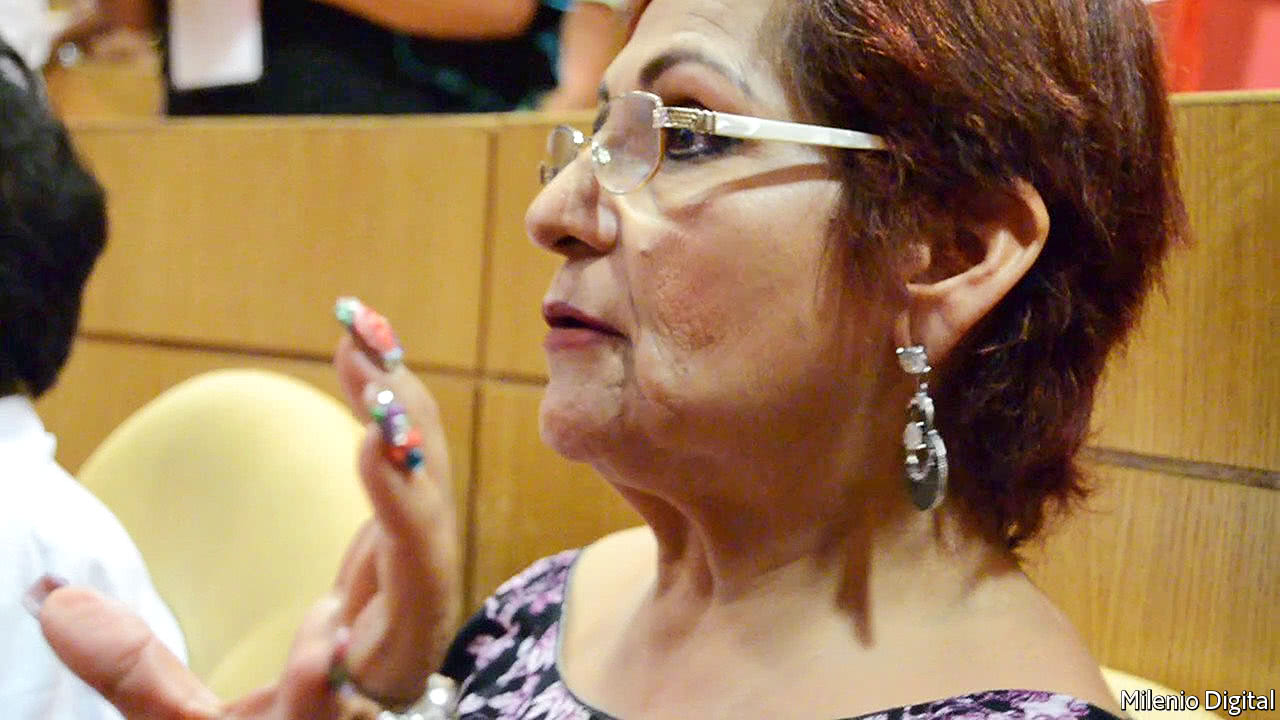The campaigner for Mexico’s disappeared was 50
THE narcos who infested San Fernando, in Tamaulipas state in north-eastern Mexico, did not always trouble to bury their victims. They left them by the side of Highway 101, a road some people said was the most dangerous in the country. Or they took them to some abandoned ranch in the rolling hills round the town, shot them and piled them up in one room. They did that in 2010 with 72 migrants from Central America, pulling them off their buses as they tried to travel to the United States.
Sometimes, though, the killers would hide their victims. Over several months in 2011 the police found 47 mass graves outside town with 193 bodies, probably bus passengers. And more graves could turn up anywhere, in the hard, stony ground among the thorn bushes. You could tell they were there because a bad smell hung around, or the ground was sunken or disturbed. Or you might spot a piece of bone. Miriam Rodríguez knew such signs well, because in 2014 she found, in just such a place, what remained of her daughter.Up till then, she had lived with the lawlessness as everyone else in San Fernando had. In the early 2000s the narcos had been around, but not too bad. If they came to the municipal market in the Plaza Hidalgo, where she ran her belts-and-bags business, they even paid for what they took. But the showy processions of SUVs with tinted windows, cruising slowly through town, became more menacing. Then the Zetas, the most brutal of the drug gangs, began to take people. The randomness was terrifying. Why, for example, did they drag away three women from the taco place beside the highway where they gave you two beers for the price of one? Why kill 193 people who had just been on the bus to Reynosa or who knew where? After that, people began to leave town; perhaps 10,000 left. Those who stayed hardly dared go out, and the shops were trashed anyway. The federal government sent the army in, and that helped, but not enough, or Karen would not have gone.
From that day in 2012, Miriam’s life changed. It became a mission. She had always been strong, full of energy, a hard worker. Now her singlehanded efforts got 16 narcos charged for Karen’s abuction and 13 sent to jail. Day after day she went to the courts to make sure they stayed there. She also began to campaign on behalf of all San Fernando’s families who had relatives who were missing. She set up two organisations for the desaparecidos, arranged Mothers’ Marches through town, supported the families, drew up a list of 800 victims to make a database of sorts, and hounded officials at every level of government.
Nothing and no one could shut her up. No se andaba por las ramas, said her friends; she didn’t beat about the bush. In a country where violence cowed too many people and journalists were killed for their reporting, she talked, and talked. Under her elegant jackets, her chunky earrings and glittery fake nails, she was a tigress. She carried a gun, too, in case any of the Zetas tried it on with her. They had once seized her husband, bundling him out of his work and into a car, but she had roared after them in hers and called in the army to arrest them.
Possibly she was too loud. She had other causes, too, such as complaining about outsiders renting space in the market, keeping locals out. At one point in her campaign for the disappeared, fed up with officials doing nothing, she appealed to the UN and the Inter-American Commission on Human Rights. In March she went eagerly to Texas to join an international procession of protest against Donald Trump’s immigration policies. It was called the Caravana contra el Miedo, against fear. She liked that.
Unanswered calls
She did want protection at home, though. She had a right to it, as she told any official who would listen. In March came the news of a massive break-out from the main state jail, 29 narcos, among them two she had put there for taking Karen. At that point she closed her business, not wanting the Zetas to track her to it, and by April she was sure that one day they would kill her. One policeman said he was on call for her; she rang him 30 times one day around four in the morning, testing, but got no answer. The police claimed to patrol past her house three times a day; she never saw them.
She did want protection at home, though. She had a right to it, as she told any official who would listen. In March came the news of a massive break-out from the main state jail, 29 narcos, among them two she had put there for taking Karen. At that point she closed her business, not wanting the Zetas to track her to it, and by April she was sure that one day they would kill her. One policeman said he was on call for her; she rang him 30 times one day around four in the morning, testing, but got no answer. The police claimed to patrol past her house three times a day; she never saw them.
Mother’s Day, May 10th in Mexico, was a date to be treated with tamales in bed and serenades. She had two other children to spoil her, though no Karen, for whom she had done her best. Her day ended when, at about 10.30pm, a hustling band of Zetas called her out of the house. If they had waited a second, she would have told them exactly what she thought of them.
www.economist.com

No hay comentarios.:
Publicar un comentario